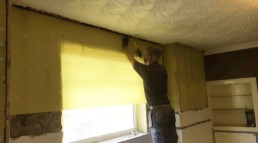What Causes Penetrating Damp?
Penetrating damp is almost always caused by defects in the exterior of the building itself, whether this is defective masonry, damage to the roof or poor window and door pointing. Cavity walls can also be affected when the external leaf deteriorates and the insulation inside the cavity starts to soak up the dampness and damage the interior of the property.
Usually these external problems consist of wear and tear, cracks and fabric defects that must be accurately diagnosed in order to solve the damp problem. For example, if a damp patch is found at guttering height, start by checking your downpipes and gutters for potential leaks. Correct diagnosis is important before any damp repairs take place, as the wrong diagnosis and repair will not solve the problem and result in the work having to be done twice, meaning double the cost.
Signs of Penetrating Damp

Below are 5 key signs of penetrating damp and what you need to look out for:
- Localised Dampness - Localised damp patches will appear on or adjacent to the external walls that are suffering from penetrating damp. These can be in random locations and will not dry out until the property defect causing it is repaired.
- Internal Decoration Being Damaged - Internal walls and decorations becoming discoloured or wet could be an indication of penetrating damp.
- Damaged Plaster - Penetrating damp will cause plaster to blister and show signs of wear and tear. This is as a result of the excess moisture affecting the fabric of the plaster.
- Rotting Skirting Boards or Floor Timbers - Floors adjacent to external walls showing signs of dry or wet rot decay may be the result of high moisture due to penetrating damp.
- Mould Growth - If there is visible mould growth alongside a musty damp smell this may indicate penetrating damp causing a cold spot which results in a condensation issue within the property.
Penetrating Damp Treatment
Our damp specialists will carry out an extensive survey of your property prior to carrying out any penetrating damp treatment. It is essential to use experts that can accurately diagnose the source of your problem, as misdiagnosis will not solve the problem and cost you unnecessary time and money. Once we know exactly what we are dealing with, we can utilise a number of different building techniques to resolve your property issue.
Depending on the severity and the scale of the problem our surveyors will specify either internal or external treatment solutions or both may be required to fix the problem. Internal waterproofing process is carried out using a waterproofing membrane. This system will prevent any external moisture penetrating the interior of your property and affecting the wall fabric and decoration. Alternative external approaches might include masonry protection using cream-based water repellent solutions or in more severe cases even an external waterproofing membrane application. The correct solution to deal with the problem is necessary to prevent damp affecting the interior of the property as well as the internal timber structures.

Penetrating Damp Surveys
Our fully qualified surveyors will investigate the affected area and assess the scale of the damp problem. We only supply expert surveyors that are highly trained in all forms of damp and rot problems that could affect your property. This means that we accurately diagnose penetrating damp problems and can identify any other damp related issues affecting your property.
